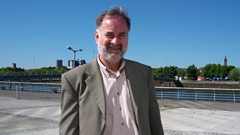Main content
An Litir Bheag 918
Litir Bheag na seachdain sa le Ruairidh MacIlleathain. Litir 脿ireamh 918. This week's short letter for G脿idhlig learners.
Last on
Sun 18 Dec 2022
14:00
麻豆官网首页入口 Radio nan G脿idheal
More episodes
Previous
Next
![]()
Corresponding Litir
Litir do Luchd-ionnsachaidh 1222
Clip
-
![]()
An Litir Bheag 918
Duration: 03:25
An Litir Bheag 918
Anns an Litir mu dheireadh, bha mi ag innse dhuibh mu dh脿 eilean faisg air ceann a deas an Eilein Sgitheanaich 鈥� Pabaigh agus Scalpaigh. Air mapa Bhlaeu on t-seachdamh linn deug, bha Pabaigh l脿n chraobhan. A bheil fianais sam bith eile ann gur e eilean coillteach a bha ann?
Gu fortanach, tha. Anns an t-siathamh linn deug, sgr矛obh pears-eaglais ainmeil cunntas dhen eilean. B鈥� esan an t-Urramach D貌mhnall Rothach, Ard-dheadhan nan Eilean.
Tha e ag innse dhuinn gun robh Pabaigh l脿n chraobhan. Tha e coltach gun d鈥� fhuair Blaeu a chuid fiosrachaidh bhon ch脿irt-i霉iliche, Timothy Pont. Bha Pont a鈥� cruinneachadh ainmean-脿ite aig deireadh an t-siathamh linn deug agus toiseach an t-seachdamh linn deug. Feumaidh gun robh Pabaigh coillteach aig an 脿m sin.
A bheil sin a鈥� ciallachadh nach robh duine a鈥� fuireach ann? Chan eil, oir sgr矛obh an Rothach gun robh Pabaigh na th猫armann do mh猫irlich agus sp霉inneadairean. Feumaidh gun robh daoine dhen t-se貌rsa sin a鈥� fuireach ann, co-dhi霉 bho 脿m gu 脿m.
Anns an leabhar aige 鈥�Pabay: An Island Odyssey鈥�, tha Christopher Whatley ag r脿dh gur e 脿ite math a bha ann airson spuinneadairean-mara. Tha an t-eilean 矛osal. Faodaidh duine seasamh ann an aon 脿ite agus gheibh e sealladh ceithir-thimcheall air.
Nuair a bhiodh soitheach faisg 鈥� math dh鈥檉haodte le bathar air b貌rd 鈥� dh鈥檉haodadh na Pabaich eathar a thoirt a-mach. Bhiodh iad a鈥� toirt ionnsaigh air an t-soitheach. Bhiodh iad a鈥� tilleadh le toradh na creiche. Bhiodh e doirbh do dhaoine an leantainn tro na sgeirean a tha timcheall an eilein. Agus nuair a bha iad anns an eilean, bhiodh na sp霉inneadairean a鈥� dol am falach anns a鈥� choille.
Carson nach do mhair a鈥� choille? An do chuir feadhainn 脿s dhi air s脿illibh an sp霉innidh? Chan eil Christopher Whatley a鈥� toirt beachd air sin. Ach tha e ag innse dhuinn gun do thadhail an Cuimreach, T貌mas Pennant, air an Eilean Sgitheanach ann an seachd ceud deug, seachdad 始s a dh脿 (1772). Sgr矛obh Pennant gun robh Pabaigh 鈥榰aine鈥� (mar gun robh e c貌mhdaichte le feur). Sgr矛obh e cuideachd gun robh an t-eilean na th猫armann do mhurtairean fada roimhe sin. Bha laithean nan spuinneadairean seachad.
Gu fortanach, tha. Anns an t-siathamh linn deug, sgr矛obh pears-eaglais ainmeil cunntas dhen eilean. B鈥� esan an t-Urramach D貌mhnall Rothach, Ard-dheadhan nan Eilean.
Tha e ag innse dhuinn gun robh Pabaigh l脿n chraobhan. Tha e coltach gun d鈥� fhuair Blaeu a chuid fiosrachaidh bhon ch脿irt-i霉iliche, Timothy Pont. Bha Pont a鈥� cruinneachadh ainmean-脿ite aig deireadh an t-siathamh linn deug agus toiseach an t-seachdamh linn deug. Feumaidh gun robh Pabaigh coillteach aig an 脿m sin.
A bheil sin a鈥� ciallachadh nach robh duine a鈥� fuireach ann? Chan eil, oir sgr矛obh an Rothach gun robh Pabaigh na th猫armann do mh猫irlich agus sp霉inneadairean. Feumaidh gun robh daoine dhen t-se貌rsa sin a鈥� fuireach ann, co-dhi霉 bho 脿m gu 脿m.
Anns an leabhar aige 鈥�Pabay: An Island Odyssey鈥�, tha Christopher Whatley ag r脿dh gur e 脿ite math a bha ann airson spuinneadairean-mara. Tha an t-eilean 矛osal. Faodaidh duine seasamh ann an aon 脿ite agus gheibh e sealladh ceithir-thimcheall air.
Nuair a bhiodh soitheach faisg 鈥� math dh鈥檉haodte le bathar air b貌rd 鈥� dh鈥檉haodadh na Pabaich eathar a thoirt a-mach. Bhiodh iad a鈥� toirt ionnsaigh air an t-soitheach. Bhiodh iad a鈥� tilleadh le toradh na creiche. Bhiodh e doirbh do dhaoine an leantainn tro na sgeirean a tha timcheall an eilein. Agus nuair a bha iad anns an eilean, bhiodh na sp霉inneadairean a鈥� dol am falach anns a鈥� choille.
Carson nach do mhair a鈥� choille? An do chuir feadhainn 脿s dhi air s脿illibh an sp霉innidh? Chan eil Christopher Whatley a鈥� toirt beachd air sin. Ach tha e ag innse dhuinn gun do thadhail an Cuimreach, T貌mas Pennant, air an Eilean Sgitheanach ann an seachd ceud deug, seachdad 始s a dh脿 (1772). Sgr矛obh Pennant gun robh Pabaigh 鈥榰aine鈥� (mar gun robh e c貌mhdaichte le feur). Sgr矛obh e cuideachd gun robh an t-eilean na th猫armann do mhurtairean fada roimhe sin. Bha laithean nan spuinneadairean seachad.
The Little Letter 918
In the last Litir, I was telling you about two islands near the south end of Skye 鈥� Pabay and Scalpay. On Blaeu鈥檚 map from the seventeenth century, Pabay is full of trees. Is there any other evidence that it was a wooded island?
Fortunately, yes. In the sixteenth century, a famous churchman wrote an account of the island. He was the Rev. Donald Monro, High Dean of the Isles.
He tells us that Pabay was full of trees. It appears that Blaeu got his information from the cartographer, Timothy Pont. Pont was collecting place-names at the end of the sixteenth century and the start of the seventeenth century. It聽 must be that Pabay was wooded at that time.
Does that mean that nobody was living there? No, because Monro wrote that Pabay was a refuge for thieves and cut-throats. People of that nature must have been living there, at least from time to time.
In his book 鈥楶abay: An Island Odyssey鈥�, Christopher Whatley says it was a good place for pirates. The island is low-lying. A person can stand in one place and he will get a view all around him.
When a vessel would come close 鈥� perhaps with goods on board 鈥� the Pabay folk could take out a small boat. They would attack the vessel. They would be returning with the booty. It would be difficult for people to follow them through the skerries that are around the island. And when they were on the island, the pirates would hide in the wood.
Why didn鈥檛 the wood survive? Did some people destroy it because of the piracy? Christopher Whatley doesn鈥檛 offer an opinion on that. But he tells us that the Welshman, Thomas Pennant, visited the Isle of Skye in 1772. Pennant wrote that Pabay was 鈥榲erdant鈥� (as if it were covered in grass). He also wrote that the island was a refuge for assassins long before that. The days of the pirates were over.
Fortunately, yes. In the sixteenth century, a famous churchman wrote an account of the island. He was the Rev. Donald Monro, High Dean of the Isles.
He tells us that Pabay was full of trees. It appears that Blaeu got his information from the cartographer, Timothy Pont. Pont was collecting place-names at the end of the sixteenth century and the start of the seventeenth century. It聽 must be that Pabay was wooded at that time.
Does that mean that nobody was living there? No, because Monro wrote that Pabay was a refuge for thieves and cut-throats. People of that nature must have been living there, at least from time to time.
In his book 鈥楶abay: An Island Odyssey鈥�, Christopher Whatley says it was a good place for pirates. The island is low-lying. A person can stand in one place and he will get a view all around him.
When a vessel would come close 鈥� perhaps with goods on board 鈥� the Pabay folk could take out a small boat. They would attack the vessel. They would be returning with the booty. It would be difficult for people to follow them through the skerries that are around the island. And when they were on the island, the pirates would hide in the wood.
Why didn鈥檛 the wood survive? Did some people destroy it because of the piracy? Christopher Whatley doesn鈥檛 offer an opinion on that. But he tells us that the Welshman, Thomas Pennant, visited the Isle of Skye in 1772. Pennant wrote that Pabay was 鈥榲erdant鈥� (as if it were covered in grass). He also wrote that the island was a refuge for assassins long before that. The days of the pirates were over.
Broadcast
- Sun 18 Dec 2022 14:00麻豆官网首页入口 Radio nan G脿idheal
All the letters
Tha gach Litir Bheag an seo / All the Little Letters are here.
Podcast: An Litir Bheag
The Little Letter for Gaelic Learners
An Litir Bheag air LearnGaelic
An Litir Bheag is also on LearnGaelic (with PDFs)
Podcast
-
![]()
An Litir Bheag
Litirichean do luchd-ionnsachaidh ura. Letters in Gaelic for beginners.




